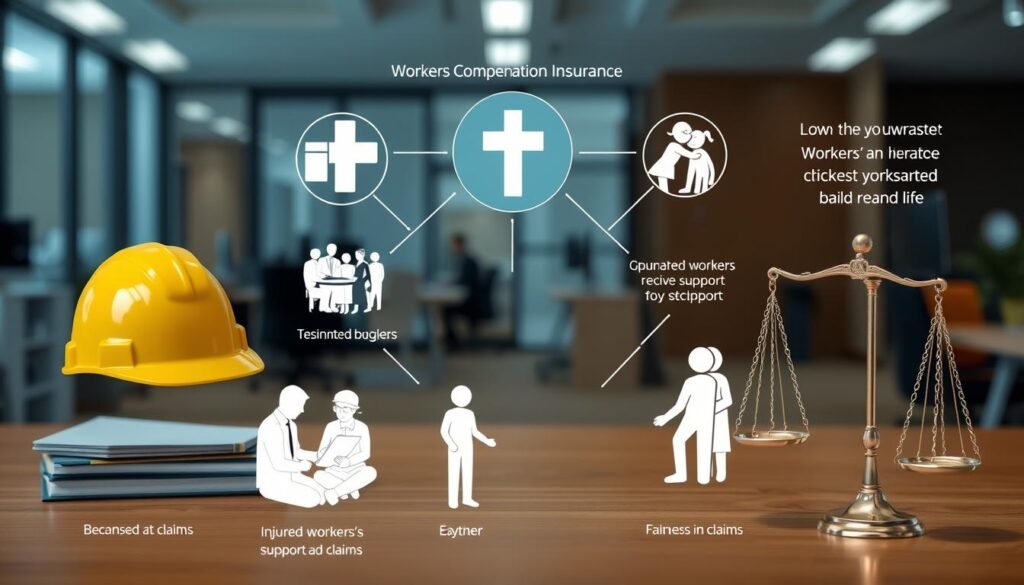Is AIA Insurance Worth It for Your Architecture Firm in 2025?
The American Institute of Architects (AIA) has special insurance for architects. It has over 100,000 members worldwide. But, is AIA insurance right for your firm?
This review looks at AIA insurance based on member feedback and market trends. We’ll see if AIA insurance meets the needs of architectural firms today.
Table of Contents
ToggleKey Findings :
- AIA members get insurance made just for architects.
- Liability insurance for architects costs about $145 a month. General liability is around $35 a month.
- Members say there are good and bad things about claims compared to others.
- Eligible firms can save up to 25% on insurance with AIA.
- Smaller firms might find it hard without good management systems
Introduction to the American Institute of Architects Insurance
The AIA offers insurance for architects’ unique risks. It helps protect against legal and financial problems in design and construction.
AIA’s insurance includes professional and general liability. It’s for the challenges architects face. The AIA Trust, started in 1952, helps with risk management.
AIA has updated its contracts to meet new standards. The last big change was in 2017. The latest update, AIA Document A101™ – 2017 Exhibit A – Insurance and Bonds, covers architects and contractors.
Knowing about AIA insurance helps architects manage risks. AIA’s services aim to protect against many practice risks.
Overview of AIA Insurance Programs
AIA’s insurance is made for architects. It covers professional and general liability. This helps protect against errors, omissions, or negligence.
AIA members get discounts on contracts and risk credits. These benefits help firms of all sizes manage risks in construction and design.
AIA has over 100,000 members worldwide. It offers networking and education. Members can keep their licenses and improve their skills.
AIA fights for its members. It helps them deal with local and national rules.
Benefits of Choosing AIA Member Insurance
Selecting AIA insurance provides architecture professionals with significant advantages. Members gain access to specialized coverage addressing the unique challenges of architectural practice. Additionally, membership comes with valuable discounts that lower the overall cost of insurance protection.
Members also benefit from financial incentives through the AIA Trust, resulting in substantial savings on their insurance expenses compared to standard market rates.
Exclusive Member Discounts
AIA members enjoy substantial discounts on educational programs, with savings of up to 40% on courses. Purchasing four or more courses qualifies members for an additional 15% discount, making professional development more affordable and accessible.
The AIA Trust also negotiates special group insurance rates, allowing members and their teams to secure comprehensive insurance coverage at competitive prices. These collective bargaining benefits translate to direct cost savings for participating firms.
Tailored Coverage for Architects
AIA insurance is specifically designed to address the unique needs of architectural professionals. The coverage is customized to accommodate the complex nature of architectural work, ensuring members receive protection that aligns with their specific practice requirements regardless of project phase.
This specialized insurance approach not only helps protect architectural firms from common professional risks but also supports their long-term success in the industry. The program’s focus on architecture-specific concerns makes it particularly relevant for firms seeking targeted risk management solutions.
Key Features of Architects Liability Insurance
Architects liability insurance provides essential protection against a range of professional risks. It shields firms from claims related to design errors, project delays, and other professional missteps. This section examines the critical components of liability coverage for architecture professionals.
Professional Liability Insurance for Architects
Professional liability insurance is a fundamental protection tool for architectural practices. It provides coverage against claims alleging professional errors, design flaws, or negligence. This insurance typically covers legal defense costs and damages awarded in professional liability claims.
Architectural firms face distinct risk profiles that may necessitate policy limits ranging up to $2 million for large or complex projects. Previous claims history can significantly impact premium costs, making risk management an essential component of long-term insurance strategy.
Many client contracts specifically require architects to maintain professional liability coverage, underscoring its importance in the industry’s risk management landscape. According to Victor Insurance, the AIA Trust’s program administrator, this coverage has become increasingly essential as projects grow in complexity and financial scope.
Architects Insurance Coverage Options
Architecture professionals can choose from multiple insurance solutions, including general liability, professional liability, and cyber liability coverage. Each policy type addresses specific risk categories relevant to architectural practice.
Cyber liability insurance has become increasingly important as architectural firms rely more heavily on digital tools and data storage. This coverage helps protect against data breaches and cybersecurity incidents. Industry experts recommend matching insurance limits to project values to ensure adequate protection.
Policies offer varied deductible options, allowing policyholders to balance premium costs against out-of-pocket expenses in the event of a claim. This flexibility helps firms customize their coverage to align with their financial situation and risk tolerance.
Member Feedback on Claims Responsiveness
Feedback regarding AIA insurance claims handling shows varied experiences among members. Many report receiving prompt assistance when filing claims, which aligns with the program’s promised service standards. However, some members express frustration with delays that negatively impact their project timelines.
Claims typically require three essential elements: documented harm or damage, an allegation of wrongdoing, and a demand for monetary compensation. Understanding these components helps contextualize the timeframe needed for claims resolution.
Timely action is crucial when managing professional liability claims. Efficient claims processing not only minimizes financial impact but also helps maintain client relationships. Some architectural professionals report wishing for more consistent timing in the claims resolution process.
These diverse experiences provide valuable insights for firms considering their insurance options. As one AIA member shared: “I appreciated the swift response when I first filed my claim, it was aligned with what I expected.” Another noted: “Unfortunately, I faced delays that really affected my project timeline during the claims process.”
Analyzing Pros of AIA Insurance

The AIA insurance program offers several significant advantages for architectural firms. Its specialized coverage addresses the unique risk factors inherent in architectural projects. Understanding these benefits helps firms make informed decisions about their insurance needs.
Specialized Coverage for Architectural Firms
A major advantage is the availability of policies specifically designed to address architects’ professional challenges. AIA insurance provides protection against common concerns including property damage and professional design errors. The 2020 Design & Construction Policy Form from Victor Insurance (the AIA Trust’s administrator) offers major enhancements including expansion of the “insured” definition, enhanced rectification applicability, and aggregated defense outside policy limits.
This specialized approach ensures architectural firms receive protection against claims arising throughout all project phases, from initial design through construction and beyond.
Access to Risk Management Resources
AIA insurance also provides members with valuable risk management tools and resources. These educational materials help firms implement best practices to reduce their exposure to potential claims. For example, Victor Insurance now offers “a new automated (AI-backed) contract review tool to help insureds mitigate contractual risk exposures in professional service contracts by scanning them to identify important practice management and insurability issues.”
This educational component enhances workplace safety and aligns with AIA insurance benefits by combining practical coverage with preventative education. According to the AIA Trust, “The AIA Trust works with members and experts to select top‑tier products that meet strict quality standards and work for individuals and firms of any size.”
Understanding the Cons of AIA Insurance
While AIA insurance offers valuable benefits, it also presents significant challenges. Financial considerations and coverage limitations are frequently cited concerns among architecture professionals evaluating these programs.
High Premiums for Smaller Firms
Premium costs represent a substantial challenge for many firms considering AIA insurance. Small and emerging architectural practices often struggle with the financial burden of comprehensive coverage. These high entry costs can make it difficult for newer businesses to secure the protection they need during their formative years.
According to industry data from Insureon, architects typically pay around $145 monthly (median cost) for professional liability coverage and approximately $35 monthly for general liability insurance. These costs can be prohibitive for smaller operations with limited cash flow.
Limited Coverage Flexibility
Another significant drawback is the relative inflexibility of coverage options. AIA insurance programs may not always provide the customization needed to address the specific risk profiles of different architectural practices. This lack of adaptability can create coverage gaps for firms with unique service offerings or specialized project portfolios.
This inflexibility highlights a crucial limitation in the AIA insurance model, demonstrating the importance of comprehensive, tailored coverage that can accommodate the diverse needs of architectural firms across various specialties and practice sizes.
Comparative Analysis of AIA Insurance vs. Competitors

Comparative Analysis of AIA Insurance vs. Competitors
Comparing AIA insurance with alternatives like Hiscox, Victor (outside the AIA program), and Travelers reveals distinctive strengths and limitations. AIA emphasizes specialized architecture-focused coverage, appealing to firms seeking industry-specific protections. In contrast, Hiscox often attracts smaller practices with competitive pricing and foundational coverage options.
This comparison provides architects with perspective on the varying cost structures among providers. AIA’s established reputation in the architecture community makes it a preferred choice for many professionals. However, competitors frequently offer more flexible plan structures that can adapt to evolving practice needs. Claims processing efficiency also varies significantly between providers, with mixed reviews across the board.
By evaluating these factors, architecture professionals can identify the insurance provider that best aligns with their specific needs. This ensures they receive appropriate coverage without unnecessary expenses, maximizing the value of their insurance investment.
Customer Service Experience with AIA Insurance
The quality of customer service provided by AIA insurance significantly impacts member satisfaction. Initial interactions often generate positive impressions among members. However, service consistency can vary depending on the representative, affecting overall satisfaction with the AIA program.
Architecture professionals report mixed experiences regarding assistance with claims and inquiries. Some praise representatives for their clear explanations and support, while others note communication challenges. These inconsistent experiences make it difficult for members to fully assess the value proposition of their insurance coverage.
Setting realistic expectations is crucial for architects considering AIA insurance options. While first impressions may be positive, experiences can differ when managing complex claims. Maintaining thorough documentation and clear communication can help mitigate potential challenges during claims resolution.
In the dynamic field of architecture, responsive and knowledgeable customer service is essential. AIA’s service quality directly influences member satisfaction and impacts future insurance purchasing decisions. As one member noted on an industry forum, “Having clear, consistent communication during claims processing is just as important as the coverage itself.”
Market Reputation of the American Institute of Architects Insurance

The AIA insurance reputation is shaped by a combination of member experiences and performance data. Better Business Bureau ratings indicate generally positive member satisfaction, though some report delays in claims processing—an issue also reflected in National Association of Insurance Commissioners (NAIC) complaint data.
The program serves architecture and engineering firms with annual revenues ranging from $100,000 to $30 million, offering coverage limits up to $5 million per claim and $5 million aggregate. Coverage extends to most U.S. states, with notable exceptions being Alaska and Wyoming.
Statistical data demonstrates a strong market position, though improvements in claims handling would enhance member satisfaction. The program boasts a solid A.M. Best rating of “A, XV” through CNA Insurance Companies, its underwriter. It also includes a valuable 50/50 consent to settle provision for claims-free risks, making it attractive to risk-averse firms.
The program’s joint venture coverage capability demonstrates its adaptability to specialized project structures, contributing to its positive reputation. Other benefits like mediation credit and worldwide coverage enhance its market appeal, though addressing BBB and NAIC complaints would strengthen its position further. Improving customer service responsiveness could significantly boost AIA’s market standing
Why Proper Insurance Matters for Architects
Insurance is a critical component of an architectural firm’s risk management strategy. It provides essential financial protection against potentially devastating lawsuits. Industry data shows that between 1994 and 2005, approximately 15 to 21 claims were filed annually for every 100 architecture firms.
Maintaining appropriate insurance coverage helps architects maintain both financial security and professional credibility. According to recent industry reports, architects pay approximately $57 monthly or $684 annually for business insurance, with professional liability insurance costing around $61 monthly on average.
Claims against architects frequently stem from client expectation misalignments rather than catastrophic construction failures. This highlights the importance of clear communication and thorough documentation.
Architecture professionals face unique liability exposures, including contract breaches and building code compliance issues. These specialized risks require tailored insurance solutions. Professional liability insurance typically offers more cost-effective protection than broader errors and omissions policies.
For small architectural practices, proper insurance coverage can be the difference between surviving a legal challenge and facing bankruptcy due to legal expenses. State-specific insurance regulations may affect coverage requirements and business operations, making local expertise valuable when selecting insurance providers.
Conclusion
Architects can find insurance made just for them. These programs have big benefits like discounts and custom options. But, they can be expensive and hard to change for small firms.
What members say about insurance is very important. How well claims are handled and customer service matter a lot. Real experiences show the value of insurance made for architects.
It’s important to look at both the good and bad of architectural insurance. This helps firms choose the right coverage for their needs. Making smart insurance choices can make a firm safer and more profitable.
AIA insurance is a big help to architects. It shows AIA cares about its members and their work. By listening to feedback and getting better, AIA can help architects meet their goals and needs.










